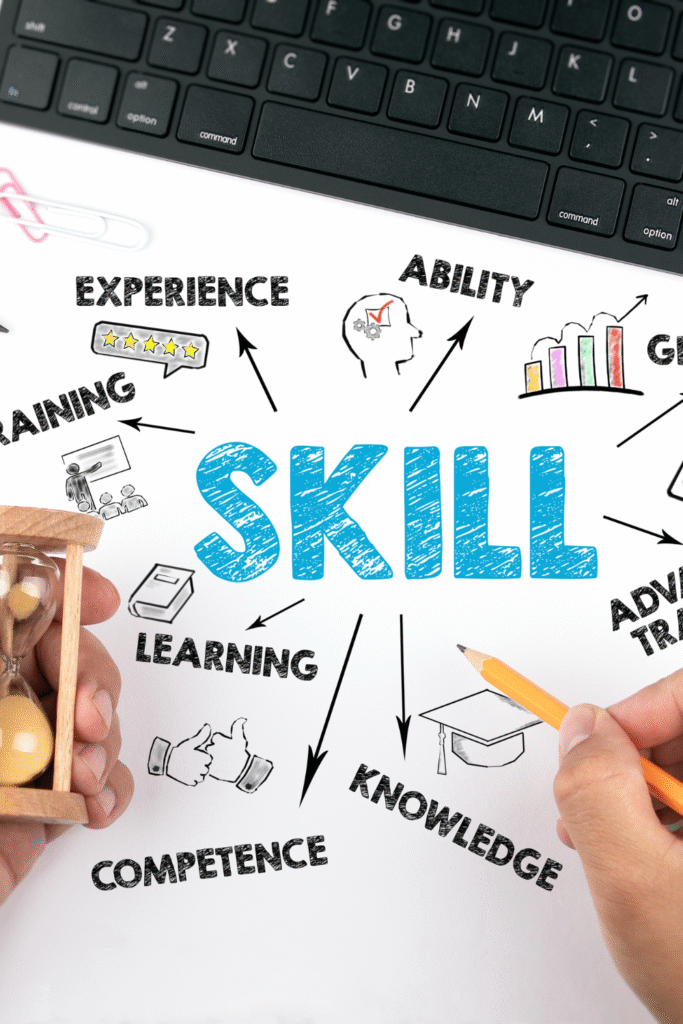Introduction
In an era defined by constant change and rapid innovation, to Master a new skill is more than just a hobby—it’s a powerful form of self-investment. Whether you’re aiming for a career pivot, personal growth, or mental enrichment, learning something new sharpens your edge and prepares you for the future. In this detailed guide, we’ll explore how to choose the right skill, develop it efficiently, and integrate it into your life for lasting transformation.
Table of Contents
- Why Investing in Yourself Matters
- Choosing the Right Skill for Your Goals
- Setting SMART Learning Goals
- Creating a Skill Mastery Plan
- Leveraging Online and Offline Resources
- Overcoming the Fear of Failure
- Staying Motivated and Accountable
- Measuring Your Progress
- Real-Life Examples of Skill Transformation
- Frequently Asked Questions (FAQs)
1. Why Investing in Yourself Matters
Self-investment is the foundation of personal and professional development. When you learn a new skill, you increase your market value, enhance your creativity, and boost your confidence.
It’s not just about gaining knowledge—it’s about showing yourself that you are worth the effort. From language learning to coding or creative writing, every skill mastered becomes a tool in your arsenal.
In today’s knowledge economy, those who continuously learn stay ahead. Think of self-growth as your most valuable long-term asset.
Investing in yourself also leads to greater adaptability in a fast-changing world. Whether it’s to stay competitive in the job market or to simply keep your mind sharp and engaged, personal development is a proactive step towards future readiness.
It also influences your mindset—you begin to see challenges as opportunities and mistakes as lessons. Self-growth fosters a sense of fulfillment, inner strength, and resilience, which enhances not only your career but your relationships and overall quality of life.
In today’s knowledge economy, those who continuously learn stay ahead. Think of self-growth as your most valuable long-term asset.
2. Choosing the Right Skill for Your Goals
Choosing the right skill requires alignment with your personal or professional goals. Are you aiming for a promotion? Consider project management or data analysis. Want more personal satisfaction? Try creative writing or a musical instrument.
The key is to pick something that excites you, fits your lifestyle, and adds tangible value. Ask yourself: What skill would positively impact my life in the next 6–12 months? Use that as your guiding star.
It’s also important to assess your strengths and weaknesses. Do a personal audit—what are your current skills, and where do you feel you lack? This clarity will help narrow down a relevant path.
Consider industry trends and future-proof skills such as AI literacy, digital marketing, or emotional intelligence. Reflect on what activities put you in a state of flow—these often reveal untapped passions worth exploring.
Additionally, factor in available time, resources, and the learning curve. Some skills require more consistent, long-term practice, while others can be grasped more quickly.
Don’t hesitate to experiment with free resources before fully committing. This exploration phase ensures you choose a skill that you’re motivated to develop over time, rather than abandoning midway due to misalignment or unrealistic expectations.
3. Setting SMART Learning Goals
Learning without direction leads to frustration. That’s where SMART goals come in:
- Specific: What exactly do you want to learn?
- Measurable: How will you track your progress?
- Achievable: Is it realistic within your schedule?
- Relevant: Does it serve your broader goals?
- Time-bound: When do you aim to reach each milestone?
Example: Instead of saying, “I want to learn French,” say, “I want to hold a 5-minute conversation in French within 60 days.”
4. Creating a Skill Mastery Plan
Planning helps break down complex skills into manageable actions. Here’s a sample weekly plan:
- Week 1: Research and gather resources
- Week 2–3: Begin foundational learning (theory)
- Week 4–6: Practice through small projects
- Week 7–8: Seek feedback and refine
- Week 9–10: Complete a capstone project
Be flexible. Life happens. The goal is consistency over perfection.
5. Leveraging Online and Offline Resources
Today, skill acquisition is more accessible than ever. Use a mix of:
- Online platforms: Coursera, Udemy, Skillshare
- Books and blogs: Deepen theoretical understanding
- YouTube tutorials: Great for visual learners
- Workshops or local classes: Add hands-on experience
- Mentors and communities: Accelerate your learning with feedback and accountability
Combine multiple formats for optimal results.
6. Overcoming the Fear of Failure
Fear often masks itself as procrastination or self-doubt. Remind yourself: mastery takes time. Every expert was once a beginner.
Normalize mistakes as part of the learning curve. You don’t need to be perfect—just better than yesterday. Reframe setbacks as learning opportunities. Courage doesn’t mean having no fear; it means acting despite it.
One of the best ways to overcome fear is by breaking big tasks into small, manageable steps.
The thought of becoming fluent in a new language or building a business can feel overwhelming, but focusing on the next small step makes the process less intimidating.
Practicing self-compassion is also crucial. Treat yourself the way you’d treat a close friend learning something new—encourage, don’t criticize.
Also, try visualization techniques: imagine yourself succeeding, even if it feels far away now. Visualization helps train your brain to believe in future possibilities.
Surround yourself with supportive people who uplift you when doubts creep in. Finally, journal your fears and progress; often, putting fears on paper strips them of power and clarifies the next right action.
7. Staying Motivated and Accountable
Motivation can fade, which is why structure and accountability are key. Try these:
- Set weekly mini-goals
- Celebrate small wins
- Share progress with a friend or mentor
- Join online communities or skill challenges
- Reflect weekly on what worked and what didn’t
Build a system where motivation follows momentum.
8. Measuring Your Progress
Tracking progress is essential to stay encouraged and adjust your strategy. Use journals, checklists, or apps to log hours practiced or milestones achieved.
Quantify your growth: “I read 3 books,” “I built 2 websites,” or “I completed 5 speaking sessions.” Progress is the ultimate motivator. Revisit your SMART goals monthly to course-correct as needed.
Another effective method is using visual tools like habit trackers or progress bars. These give you an at-a-glance understanding of how far you’ve come and what’s left to conquer.
Reflective journaling is also powerful—write about what you’ve learned, what challenged you, and how you overcame obstacles. It not only tracks success but builds self-awareness.
For skills tied to performance (like writing or public speaking), recording yourself can be invaluable. Review these records periodically to measure improvement over time.
Additionally, gather external feedback—ask mentors, peers, or online communities for constructive criticism. Progress isn’t always linear, so celebrate small wins and keep pushing forward with a growth mindset.
9. Real-Life Examples of Skill Transformation
| Person | Skill Learned | Time Frame | Outcome |
|---|---|---|---|
| Sarah (35) | Graphic Design | 6 months | Launched a freelance business |
| Ahmed (28) | Public Speaking | 3 months | Gave a TEDx talk |
| Priya (42) | Data Analytics | 9 months | Switched to a tech career |
| Daniel (30) | Guitar Playing | 5 months | Performs weekly at local events |
These transformations began with one choice: to start. Your story could be next.
10. Frequently Asked Questions (FAQs)
Q1: What’s the best skill to learn right now?
It depends on your goals, but trending skills include coding, data analytics, digital marketing, public speaking, and emotional intelligence.
Q2: How much time should I invest daily?
Start with 30 minutes daily. Consistency beats intensity over time.
Q3: What if I lose motivation halfway through?
Revisit your why. Join a support group or set new micro-goals to reignite your drive.
Q4: Can I learn a skill while working full time?
Yes. With the right plan, even 30–60 minutes a day adds up quickly.
Q5: Are free resources enough to master a skill?
Many free resources are high quality. Combine them with practical application and feedback.
Q6: What if I fail or make mistakes?
Mistakes are part of the process. Use them as feedback, not failure.
Q7: Should I learn one skill at a time?
Yes, especially if it’s your first time intentionally learning. Focus enhances depth.
Q8: How do I stay consistent?
Schedule learning time, track progress, and reward milestones.
Q9: Can learning a skill improve my mental health?
Yes! It boosts confidence, provides purpose, and reduces anxiety by focusing the mind.
Q10: What’s the fastest way to learn?
Immersion—surround yourself with the skill daily: practice, read, watch, and reflect.










